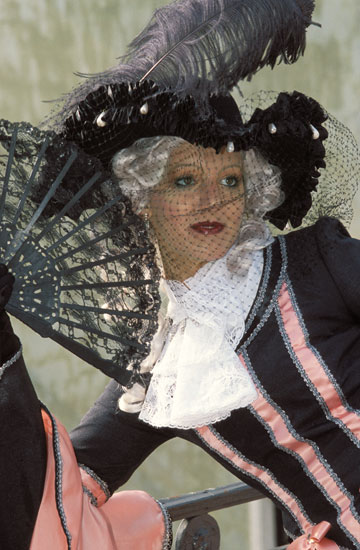People can be photographed in any environment, and may be surrounded by unattractive clutter. Consequently a background deserves a good deal of care. Unfortunately, the need to focus closely on a subject can distract the eye from other elements of an image. This is one of the most common mistakes made by inexperienced photographers.
 Background distractions take many forms. Lack of uniformity, strong colours or a mass of detail in sharp focus can lead the eye away from the centre of interest. Avoid posts that project from the subject's head, and disembodied limbs that creep into the edges of the frame. Then look for a background that is reasonably uniform, muted and lacking in detail.
Background distractions take many forms. Lack of uniformity, strong colours or a mass of detail in sharp focus can lead the eye away from the centre of interest. Avoid posts that project from the subject's head, and disembodied limbs that creep into the edges of the frame. Then look for a background that is reasonably uniform, muted and lacking in detail.
Interest can be removed from the background by defocusing, controlling contrast or blurring. With a telephoto lens set to a large aperture, depth of field is limited and background detail drops out of focus. The effect is more pronounced when the subject is kept well away from background objects - a distance of a couple of metres can be sufficient. Contrasting colours or light levels may be more difficult to conceal. Defocusing softens transitions from dark to light, and from one colour to another, but the basic contrast remains. A startling mixture of complementary colours, such as red and blue, will also distract the eye. Consequently, it may be preferable to avoid a background of this nature unless it is a feature of the photograph. In difficult situations, move around and observe how the background changes. A single step in a particular direction may resolve the problem. Finally, blurring can be used to obscure detail when there is subject movement. For instance, panning a camera set to a slow shutter speed, such as 1/30 second, reduces the background to nondescript streaks.
A completely different approach is to ensure that the background complements the subject in an unobtrusive manner. An easel bearing a canvas might provide a suitable background for a portrait of an artist. Alternatively, broader background detail can be incorporated into the design of the image and used to provide context for the subject. The artist might, for example, be shown working in a complete studio environment with much of the background detail clearly visible. A wide-angle lens used close to the subject will achieve this result, although the design of the image may be more difficult to control. A measure of balance, such as that provided by a lightweight secondary subject, may be beneficial in images of this type.






